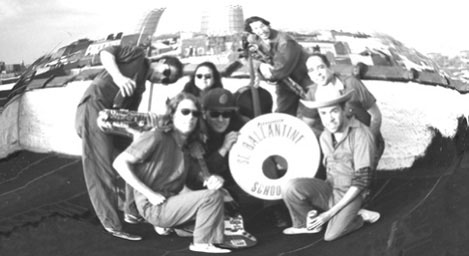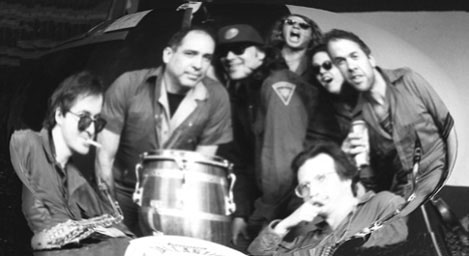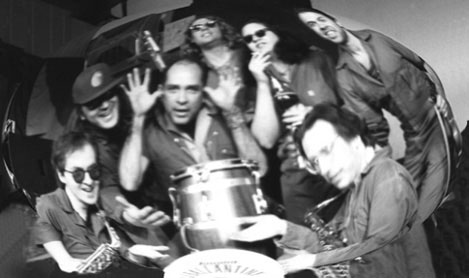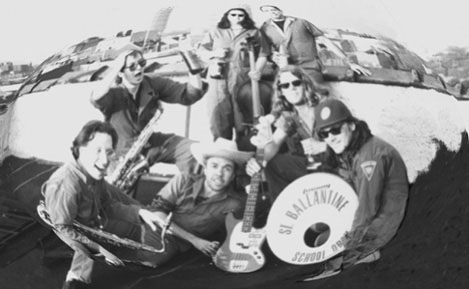
1990-1997

|
PART I: THE ILLUMINATION Considered a "curiosity" by his peers (for his feverous obsession with tuning forks) and labeled a "libertine" by superiors (for his study of Copernican Theory with Galileo), 33-year-old Father Carlo Ulissi Ballantine (b. July 4, 1600, Milan) is dispatched to supervise La Iglesia de Maria Sangria, a minor mission in Cuenca, Equador. Balantine's residency respires uneventful for three years until Thursday, November 22, when an outbreak of echolalia (a.k.a. Mendoza's Malapropa) sweeps through the Indian population. Toiling for weeks without sleep or soup, Ballantine brakes the epidemic with a vigorous ministration of "noise therapy." Soon, the chapel swells with gifts of indigenous herbs, malt-based liqueurs, and musical instruments fashioned from brass, glass, skin and bone. The Sunday service becomes increasingly fluenced by the mushrooming congregation (including "fugitive" African and West Indian disciples) and, more viscerally, by the mushrooms, Yage and Cannabis piling up in the rectory. By 1657, Ballantine's Ayuahuaska Miracle Mass is legendary throughout the Americas. Envisioning a "universal pharmacognizant metamusical idiom," Father Carlo petitions the Vatican to sanction "a school of pancultural, polyrhythmelodic psalmology," but the request goes unnoticed in Rome due to a clerical error. Ballantine bites the bullet. |

PART II: THE RAPTURE Near the end of the century (and Father Carlo's terrestrial life), several bastard Ballantine School Orchestras appear in the Old World. According to Ernesto van Damme's Heroes & Heretics, Ballantine personally founds five "musicalchemical academies" in Europe, then mysteriously vanishes from the nape of the Earth near Loch Ness, Scotland. More sound sources maintain that the Padre checks out in Peru while conducting his final "strict tempo" ritual: Immediately after injesting a potent compote of toad venom and nipplewort nectar, Ballantine insists that he be flung headlong into the roiling sea, but his ardent partisans, in a frenzied fit of Christ Conciousness, abruptly lash the holyman to a tamarin tree, slash his jugular, then fitfully lap up every drop of the precious, puissant Ballantine oil; a spontaneous ball-lightning storm rips through the flux, leaving in its wake the sanctified scent of seared flesh and ozone; three interlinking altocumulus "halos" appear briefly in the firmament. |

PART III: THE REVELATION At 3:16 pm, May 1st, 1775, Dr. Adam Weishaupt, a Ballantine School alumnus and professor of Canon Law at Ingolstadt University in Bavaria, initiates a campaign to promote Ballantine to divine sainthood. Meanwhile... in Rome, the newly elected Pope Pius VI, a suspected diabolist and digitalis addict, enacts a wholesale ouster of aledged enemies; The Purge includes Freemasons, Rosicrucians, Electricians, and posthumously, a vexing, enigmatic priest (guess who?) who would have been merely a dim church memory if not for the inexplicable discovery of his jawbone in a Vatican crypt. Meanwhile... in Philadelphia, to more than a few confounded congressmen, Thomas Jefferson cites Father Carlo in a frothy discourse on lingual freedom; the rambling rant concludes with the chronic Ballantine credo, "Face the Pump!" Meanwhile... in Cartagena, Colombia, a three-day slave rebellion is quashed by Spanish soldiery; the "instigators" retreat to interior Brazil and forge the city-state of San Ballantin. Exactly one year later, Adam Weishaupt jump-starts the Order of the Illuminati. |

PART IV: THE CLARION While not officially canonized, devotees commonly refer to Father Carlo as Saint Ballantine. In 1916, Hugo Ball, founder of the Cabaret Voltaire in Zurich, describes in his diary one particular performance thusly: Tzara is wiggling his behind like the belly of an Oriental dancer. Janco is playing an invisible violin. Huelsenbeck is banging away on the great drum, with Arp accompanying him on piano. A pure pandemonium worthy of Saint Ballantine. In 1939, New York's Museum of Modern Art presents a retrospective of Futurist sculpture, featuring Umberto Boccioni's "Saint Ballantine's Hat." In 1962, Pier Paolo Pasolini scraps the filming of "The Gospel According to Saint Ballantine" in Mexico when his lead actor mysteriously vanishes into a lucent, viscous vapor that envelops the set and setting, leaving in its wake an algid, sweet pungence not unlike nitrous oxide; three "crop circles" are discovered in an ajoining poppy field. |

PART V: THE REFORMATION In 1990, a handful of kindred musicians, including several from postmodern dance bands of yore (The Dancing Cigarettes, Fudge Factory, Carey's Problem), cluster in Williamsburg, Brooklyn to revest the Ballantine School Orchestra. Pursuant to a relentless spate of spitting, sprawling improvisational rub-a-dub, incorporating snippets of pop tunes ("Mr. Sandman," "Peter Gunn," "Tomorrow Never Knows," the Koolman ice cream truck jingle, etc.), the group ultimately performs at New York City watering holes (the Bank, Brownies, Fez, Mercury Lounge, New Music Cafe, the Pyramid, the Right Bank, the Spiral, Street Level, Under Acme), seats of higher learning (CUNY Graduate Center, Hunter College Art Gallery), and on radio (WFMU). In 1992, Domecq Luera writes: "Big and goofy, funky but sloppy. Rooted in postpunk, '60's Zappa and Hoosier marching bands, they approach every song with a spin and a grin and plenty of slack. They sputter, then swing. They stagger, then spout. Horns that zing like sweet and sour sauce. Bass and drums tickled by a cello bow. Saint Ballantine [the band] is the discombobulated child of Duchamp and a cornstalk." Now, the grooves are more tightly wound, but the spirit of Father Carlo Ulissi Ballantine remains radiantly intact. |